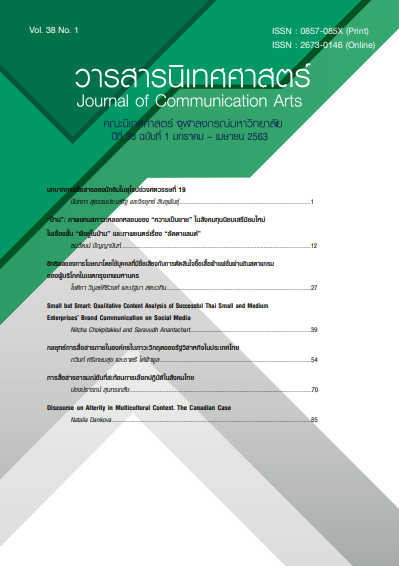Small but Smart: Qualitative Content Analysis of Successful Thai Small and Medium Enterprises’ Brand Communication on Social Media
Main Article Content
Abstract
Aiming to explore effective social media message strategies for small and medium enterprises’ (SMEs) brand communication, a qualitative content analysis was conducted to enrich each strategy’s details and expand the horizon of social media content analysis mostly used the quantitative methodology. Thematically analyzed, all 3,147 Facebook posts during 2015-2017 of eight awarded Thai SMEs yielded 19 subcategories of content strategies reflecting three SMEs’ brand communication practices: presenting brand identity; practicing brand-related marketing activities; plus leveraging secondary associations.
Article Details
References
Aaker, D.A. (1996). Building strong brands. New York, NY: Free Press.
Altman, E. I., & Sabato, G. (2007). Modelling credit risk for SMEs: Evidence from the U.S. market. Abacus, 43(3), 332-357.
Ashley, C., & Tuten, T. (2014). Creative strategies in social media marketing: An exploratory study of branded social content and consumer engagement. Psychology & Marketing, 32(1), 15-27.
Batra, R., Myers, J. G., & Aaker, D. A. (1996). Advertising management (5th ed.). Englewood Cliffs, NJ: Prentice-Hall.
Bernard, H. R. (2013). Social research method: Qualitative and quantitative approaches (2nd ed.). Thousand Oaks, CA: Sage.
Centeno, E., & Hart, S. (2012). The use of communication activities in the development of small to medium-sized enterprise brands. Marketing Intelligence & Planning, 30(2), 250-265.
Centeno, E., Hart, S., & Dinnie, K. (2013). The five phases of SME brand-building. Journal of Brand Management, 20(6), 445-457.
Coviello, N. E., Brodie, R. J., & Munro, H. J. (2000). An investigation of marketing practice by firm size. Journal of Business Venturing, 15(5-6), 523-545.
Facebook. (2017, December 31). Facebook reports fourth quarter and full year 2017 results. Retrieved March 12, 2018, from https://investor.fb.com/investor-news/press-release-details/2018/ Facebook-Reports-Fourth-Quarter-and-Full-Year-2017-Results/default.aspx
Gibson, T., & van der Vaart, H. J. (2008). Defining SMEs: A less imperfect way of defining small and medium enterprises in developing countries. Brookings Global Economy and Development, 1-29.
Gilmore, A., Carson, D., & Grant, K. (2001). SME marketing in practice. Marketing Intelligence & Planning, 19(1), 6-14.
Keller, K. L. (2013). Strategic brand management: Building, measuring and managing brand equity (4th ed.). Harlow, UK: Pearson Education.
Krake, F. B. (2005). Successful brand management in SMEs: A new theory and practical hints. Journal of Product & Brand Management, 14(4), 228-238.
Kusumasondjaja, S., Shanka, T., & Marchegiani, C. (2012). Credibility of online reviews and initial trust: The roles of reviewer’s identity and review valence. Journal of Vacation Marketing, 18(3), 185-195.
Nakara, W. A., Benmoussa, F. Z., & Jaouen, A. (2012). Entrepreneurship and social media marketing: Evidence from French small business. International Journal of Entrepreneurship and Small Business, 16(4), 386-405.
Nimsuwan, W., & Polnigongit, W. (2013). The concepts of selecting communication tool on a fan page on Facebook and attitudes, motivations affected to communication tool decision to Click “LIKE” on a fan page on Facebook of small and medium enterprises. Suranaree Journal of Social Sciences, 7(1), 37-67.
Nobre, H., & Silva, D. (2014). Social network marketing strategy and SME strategy benefits. Journal of Transnational Management, 19(2), 138-151.
Odoom, R. (2016). Brand-building efforts in high and low performing small and medium-sized enterprises (SMEs). Journal of Small Business and Enterprise Development, 23(4), 1229-1246.
Opoku, R. A., Abratt, R., Bendixen, M., & Pitt, L. (2007). Communicating brand personality: Are the web sites doing the talking for food SMEs? Qualitative Market Research: An International Journal, 10(4), 362-374.
Office of SMEs Promotion (OSMEP). (2011). Definition of SMEs. Retrieved September 3, 2017, from https://www.sme.go.th/Pages/Define/Define.aspx
Renton, M., Daellenbach, U., Davenport, S., & Richard, J. (2015). Small but sophisticated: Entrepreneurial marketing and SME approaches to brand management. Journal of Research in Marketing and Entrepreneurship, 17(2), 149-164.
Rode, V., & Vallaster, C. (2005). Corporate branding for start-ups: The crucial role of entrepreneurs. Corporate Reputation Review, 8(2), 121-135.
Rohm, A., Kaltcheva, V. D., & Milne, G. R. (2013). A mixed-method approach to examining brand-consumer interactions driven by social media. Journal of Research in Interactive Marketing, 7(4), 295-311.
Schreier, M. (2012). Qualitative content analysis in practice. Thousand Oaks, CA: Sage.
Shen, B., & Bissell, K. (2013). Social media, social me: A content analysis of beauty companies’ use of Facebook in marketing and branding. Journal of Promotion Management, 19(5), 629-651.
Sirarojananan, M. (2017). Buddhism: The foundation of Thai identity. Asia Pacific Journal of Religions and Cultures, 1(3), 75-84.
Spence, M., & Essoussi, L.H. (2010). SME brand building and management: An exploratory study. European Journal of Marketing, 44(7/8), 1037-1054.
Strauss, A. L., & Corbin, J. M. (1998). Basics of qualitative research: Techniques and procedures for developing grounded theory (2nd ed.). Thousand Oaks, CA: Sage.
Suntivong, D. (2014). Make or break it in SMEs brand building, an empirical study of the impact of brand development on the performance of Thai SMEs. Journal of Business and Management, 16(4), 19-28.
Upshaw, L. B. (1995). Building brand identity: A strategy for success in a hostile marketplace. New York: John Wiley & Sons.
Vatanasapt, V., & Stoppe, S. P. (2018). Thai cultural values and the role of third parties in addressing conflict. In Conflict resolution in Asia: Mediation and other cultural models (pp. 83-106). London: Lexington.
World Trade Organization. (2016). World trade report 2016: Leveling the trading field for SMEs. Geneva, Switzerland: WTO Publications.


